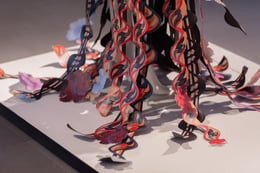Login
Registered users

Consumers have shown a growing desire to contribute to reducing their impact on the environment and creating a more sustainable planet through their daily choices. According to the last three years of reports by McKinsey & Company, this trend is also reflected in the key shifts in direction being taken now by the fashion industry. Even before the pandemic, the management consultants had identified a number of significant themes in the sector, including a revolution in materials, a culture of inclusiveness, and measures based on sustainability. These key findings from The State of Fashion 2020, a report written in partnership with the Business of Fashion (BoF), again appeared in the latest report:
“Globally, the fashion industry is responsible for around 40 million tonnes of textile waste a year,” the report reads. “Textile production, meanwhile, consumes vast quantities of water, land, and raw materials.”
According to McKinsey & Company data, in the European Union the textile and fashion sector is the fourth-largest consumer of water and raw materials, behind only food, housing, and transport. For these reasons, it’s becoming increasingly urgent to embark upon a path towards a circular economy that can reduce production waste, the carbon footprint, and the consumption of raw materials.
According to the latest report, one of the most important levers available to the fashion industry is closed-loop recycling, that is, a model whereby textile product waste (both post-production and post-consumer) is recycled into new textile products so that the materials remain in constant circulation within the same production sector. This model differs from open-loop recycling, in which one product is recycled into a different product from a different supply chain.
The report clearly highlights a need to accelerate this process. A similar conclusion was made in the discussion sessions at the recent Design Academy Eindhoven Graduation Show. Several action plans could be based on the works presented by the students at the Dutch academy, some of which also put the spotlight on alternative approaches for the fast fashion industry. So, what are the environmental and social costs of disposable fashion – that is, clothes that are worn a few times and then thrown away?

Additional impetus to continue these shifts in direction could come from both the new generation of designers and the European Commission, which, to counter the abuse of the term sustainable and to make truly sustainable products the norm, presented a large package of proposals in late March with its European Green Deal plan.
Generally aimed at making physical goods more environmentally friendly, circular, and energy efficient throughout their whole life cycle, the package includes a specific strategy to “make textiles more durable, repairable, reusable, and recyclable, to tackle fast fashion, textile waste, and the destruction of unsold textiles, and ensure their production takes place in full respect of social rights …. The specific measures will include ecodesign requirements for textiles, clearer information, a Digital Product Passport, and a mandatory EU extended producer responsibility scheme.” To address the fast fashion problem, the strategy also calls on companies “to reduce the number of collections per year, take responsibility, and act to minimize their environmental and carbon footprints, and on Member States to adopt favorable taxation measures for the reuse and repair sector.”

One of the Eindhoven Design Academy graduates in 2021 was Elena Naumann. In a project titled Left to Use, which was nominated for the René Smeets Award, she investigates potential uses of textile waste. The diagnosis that emerges from her project was of a world with an unhealthy habit of wasting large quantities of fabric. Not willing to stand by and do nothing, Naumann came up with the elegant remedy of combining different materials by weight to create recycled clothes based around the basic pattern of the kimono. This choice was made because of the garment’s straight lines and loose fit, making it adaptable for different styles of clothes, ranging from jackets to dresses.

Can the design, form, and material composition of architecture and fashion exist in harmony with the ecosystems they occupy? The pioneering work of Neri Oxman sets out to answer these questions. Her work led her to the concept of material ecology: “A design philosophy, research area, and scientific approach that explores, informs, and expresses interrelationships between the built, the grown, and the augmented.” Working at the point where technology overlaps with biology, architect and designer Oxman, who heads a team at MIT in Boston, is calling for a fundamental shift in the way we design and construct the built environment, from consuming nature to augmenting it. As architectural as much as artistic, her projects have physical properties that seamlessly match their environment without detracting from it. They turn rigidity to elasticity, and color to transparency.
The technologies developed bring a radically innovative approach to design and production, in which almost any biomass is transformed into biomaterials that can be used for a variety of purposes, including the production of clothing. Corn, for example, can be transformed into plastic.
With the Wanderers collection, she created wearable 3D-printed clothing that generates a given amount of biomass. Some convert light into energy, others light up the dark with their own fluorescence. In other words, each garment transforms elements in the atmosphere into other elements that support life. They’re textiles made of engineered living matter with completely new functions compared to standard fabrics. Will the clothes of the future no longer be made of fibers? Will they no longer be inanimate?
Among Oxman’s most iconic creations was the Silk Pavilion installation, a living dome created by hundreds of silkworms.

The current exhibition of 18 paper dresses designed by Caterina Crepax sets out to demonstrate how fashion and sustainability can coexist and communicate effectively. Titled La gentilezza della carta. La sostenibilità è bellezza (The kindness of paper. Sustainability is beauty), the exhibition opened in December 2021 and will continue to April 2022 at the Fashion Research Italy Foundation’s headquarters in Bologna.
These paper dresses, true works of art created by hand, are a tribute to beauty. Through its succession of different designs and colors, the exhibition presents the artist’s vision and the dreamlike imagery she creates. A celebration of Italian style and an exploration of pressing topical issues, such as sustainability and waste, the event focuses on paper as a circular material that’s endlessly transformable. A light material that the artist uses to give form to dreams of nature, Asia, and classical mythology, the paper used was produced using 100% recycled fibers by the historic Cordenons paper mill.
The mannequins, Schläppi 2200 models from Bonaveri, reflect the same philosophy, with each made from an innovative material generated from renewable sources. Bonaveri released the first biodegradable mannequin in 2016, taking sustainability to a new level. The natural, biodegradable plastic in question is called BPlast, and is produced from 72% sugar cane derivatives. It’s painted with BPaint, a plant-based paint. This eco-sustainable product reduces CO2 emissions compared to the most commonly used petrochemical plastics.

“The biggest opportunity for fashion is recognizing that the future can’t in any way be aligned to an economic growth logic. We have to recognize that we’re on a finite planet and we have to work within planetary limits. Where the work needs to happen is to try to find new ideas about what fashion can be.”
This was what Kate Fletcher had to say in an interview published in the Guardian as part of a feature on seven visionaries fighting for the future of the world. Fletcher believes that simply developing new materials isn’t enough to solve all the sector’s problems since it’s ultimately a cultural issue:
“What we’re facing is a fashion industry that’s going to radically reduce in scale and become way more localized; and also be much more plural – so have much more diverse representation, drawing upon all of the traditions that we know of in Indigenous groups.”
Kate Fletcher is a pioneer of sustainability in fashion, as well as a designer, activist, writer, and professor at the University of the Arts London and the Royal Danish Academy in Copenhagen. With Mathilda Tham she wrote Earth Logic: Fashion Action Research, a book that examines her own pioneering concept of earth logic: “a visionary and radical invitation to fashion researchers, practitioners, business leaders, and decisionmakers to call out as fiction the idea that sustainability can be achieved within economic growth logic; and instead to ‘stay with the trouble’ of envisioning fashion connected with nature, people, and long-term healthy futures.”
In 2018, a collection of her work was translated into Italian and released as Moda, design e sostenabilità (Fashion, design, and sustainability):
“Ideas and language associated with speed pepper the fashion landscape. In the last ten years ‘fast’ and ‘slow’ have both been paired with ‘fashion’ in neologisms meant to connote a wide range of practices that are either more or less large-scale, logistics-dominated, economic growth-focused, ethical, or ecological, in ways heavily influenced by the food sector. Indeed, like fast food, fast fashion is mass-produced and standardized.”
On the subject of nature, she says, “A relationship with nature is both a personal necessity for me and I would wager vital for all of us. My own ecological literacy has afforded me a gorgeous friendship with the natural world. I have never felt worse for wandering about outside. As I see it, its power is in us understanding that nature has a value that goes beyond its usefulness to us. The literacy this gives us – the knowledge this gives designers – is deeply held and has the potential to shape all our ideas and actions. It is uniquely powerful.”










Please refer to the individual images in the gallery to look through the photo credits